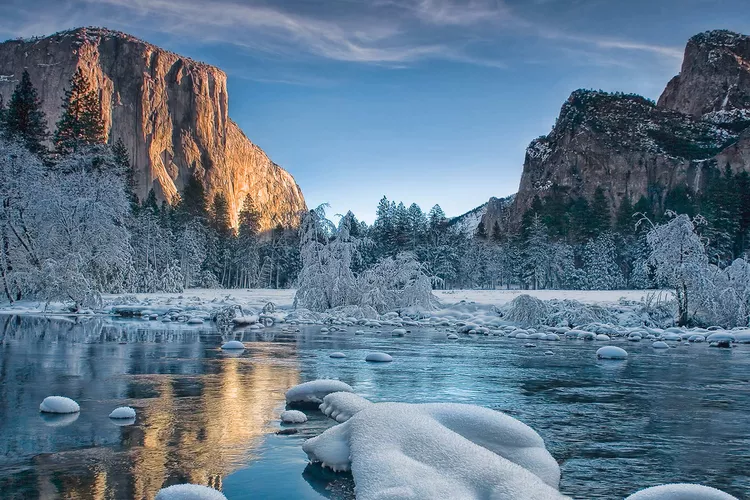Summary
Small crowds, big fun — here’s why a Yosemite winter visit should be on your travel list and what to know before you go.
Warm weather may lure the majority of Yosemite National Park travelers, but there’s a reward for those who visit this outdoor adventure destination in the winter: thinner crowds.
“Winter here is quieter; it’s a really magical time, especially when there’s snow on top of Half Dome or the falls,” Yosemite public affairs officer Scott Gediman shared with GoTravelDaily. Gediman has worked as a ranger at Yosemite for over 25 years. “If you have a good vehicle, tire chains, and you’re prepared [for the weather], it’s really special — plus, a lot of people don’t even think about coming this time of year.”
While Yosemite does experience a few seasonal closures, it remains open year-round and offers cold-weather adventures like skiing, snowshoeing, and ice skating. Here’s why a Yosemite winter should be on your travel wish list, and what to know before you go, focusing on the best hikes and views as well as essential safety precautions.
Discover the Magic of Yosemite in Winter
The beauty of winter in Yosemite can be breathtaking. With snow-capped peaks and serene landscapes, this season presents a unique opportunity for memorable experiences. However, preparation is key to enjoying everything it has to offer.
Explore Open Trails
Yosemite backpacking may get trickier in the colder months, often requiring skis or snowshoes along with solid winter navigation skills. Gediman warns, “With snow in the backcountry, we see more search and rescues as people lose the trail.” Therefore, it’s crucial to know and respect your limits for both your safety and that of others.
The good news is that many of the gentler Yosemite day hikes remain accessible during the winter. Some of the most scenic winter hikes in Yosemite include:
- The one-mile, wheelchair-accessible Lower Yosemite Fall path
- The two-mile round-trip route to Mirror Lake
- The 11.5-mile Yosemite Valley Loop for those seeking a longer challenge
Driving Safely in Snowy Conditions
During winter, you’ll probably need more than a four-wheel-drive vehicle to access Yosemite. Tire chains are required by federal regulation on snowy and icy roads (typically November through March, and sometimes as early as September) regardless of vehicle type, according to the National Park Service website.
Importance of Layering Your Clothing
The weather in Yosemite can be unpredictable during winter. Gediman advises visitors to “be prepared for everything.” This means having outer layers that repel rain or snow, while also being ready for unseasonably warm days, potentially reaching 50 degrees Fahrenheit. Besides packing layers, bring gloves, water, a flashlight, a portable phone charger, and other supplies in case you get lost or delayed due to conditions.
Fun Winter Activities

While countless visitors experience Yosemite by hiking, winter opens up more outdoor adventures through snowshoeing and skiing. The Badger Pass Ski Area serves as the primary winter sports hub, offering downhill and cross-country skiing, snowboarding, and tubing (depending on snowfall). Moreover, park rangers conduct brief snow sports excursions throughout the winter, such as snowshoeing.
Go Ice Skating at Curry Village
Ice skating at Yosemite’s Curry Village rink is a cherished tradition. The family-friendly venue, featuring stunning views of Half Dome and inviting fire pits, typically opens from mid-November to mid-March, depending on the weather. Tickets are available online or at the Curry Village Tour & Activity Desk.
Add Horsetail Fall’s “Firefall” to Your Calendar

One of the most captivating winter events in Yosemite is the “Firefall.” This spectacle occurs when sunlight illuminates Horsetail Fall (located on the eastern side of El Capitan), creating the illusion of a fiery cascade. With ideal conditions (a clear western sky at sunset and sufficient water flow), it can be observed in late February. Be mindful that the park has implemented crowd control measures in the past, including a reservation system and viewing restrictions from Yosemite Valley Lodge to the El Capitan Crossover.
Wildlife Spotting in Yosemite

Yosemite is home to a diverse range of animal species, including the striking black bear, Sierra Nevada red fox, mountain lion, and deer. Many of these creatures can be spotted year-round, but winter is particularly favorable for spotting the elusive bobcat.
Monitoring Seasonal Closures
Although the park and its visitor centers in Yosemite Valley and Wawona remain open throughout the year, certain areas face seasonal closures. Tioga Road typically closes from November through late May or early June. During this time, vehicles cannot travel between Crane Flat and Tioga Pass, according to the National Park Service. In addition, the road leading to Glacier Point is closed to vehicle traffic during winter. Stay informed about these circumstances by checking the park’s alerts page.
Cultural Respite at Park Museums
For a brief escape from the chill, consider visiting the museums located in and around Yosemite. The Yosemite Museum, which is open year-round, highlights the culture of the region’s Indigenous peoples, including the Miwok and Paiute tribes. Additionally, photography enthusiasts can appreciate The Ansel Adams Gallery, showcasing the works of the celebrated landscape photographer. This gallery is open year-round but closes on Thanksgiving Day and Christmas Day.





